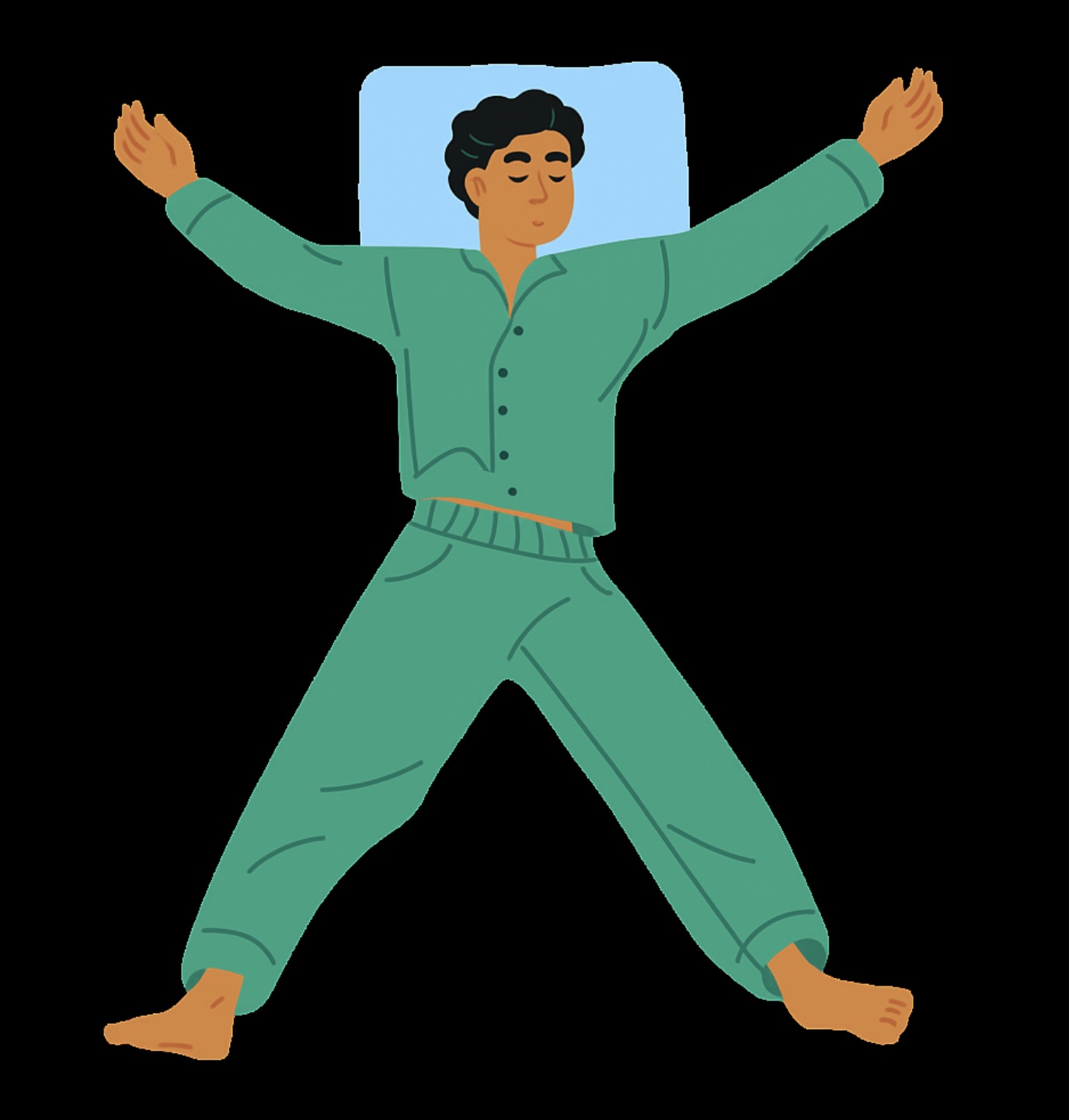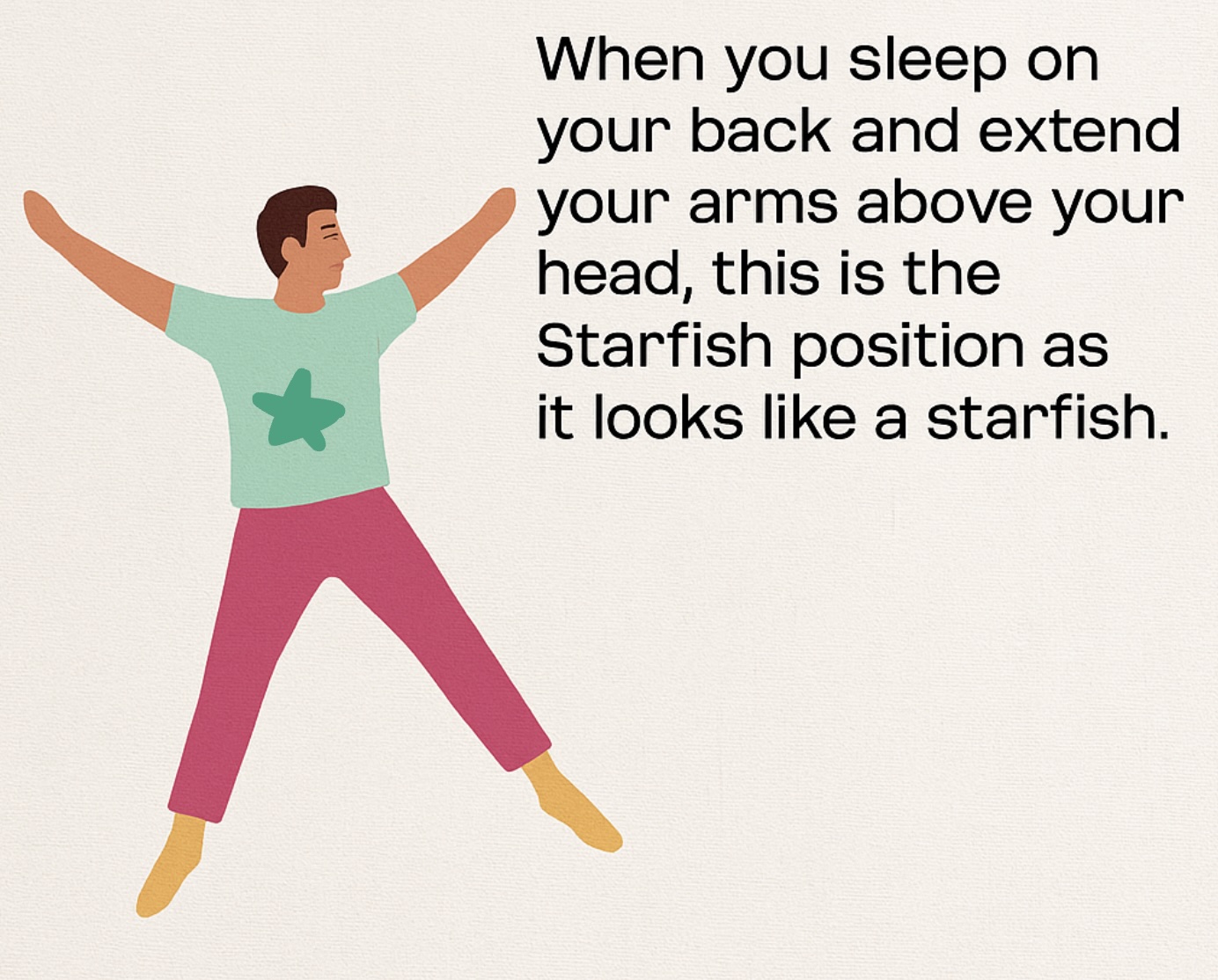.jpg)
You might have heard that you sleep like a “starfish” from your spouse or family members. What that means is you sleep with your arms stretched overhead like a starfish. This sleeping position, aptly named the "starfish," involves lying on your back with arms extended above your head and legs spread comfortably apart. You might wonder why your sleeping position is important. Many people don’t realize that the way you sleep actually impacts different parts of your body and health. Let’s dive deeper into whether this seemingly carefree sleeping style is helping or harming your health?

Only about 5-7% of people regularly sleep in the starfish position, making it one of the less common sleep postures. Yet this unique sleeping style has captured the attention of sleep researchers and healthcare professionals due to its distinct physiological effects on the body.
From a biomechanical perspective, the starfish position offers several advantages for spinal health. Back sleeping positions, including the starfish, naturally make it easier to keep your spine aligned, which is crucial for preventing pain and stiffness.
Research on spinal alignment during sleep shows that proper spine support in neutral position can significantly impact sleep quality. The starfish position allows your vertebrae to maintain their natural curves without the rotational stress that can occur with side or stomach sleeping.
We asked Dr. Michael Grandner, Sleep Expert and Professor of Neuroscience and Physiological Sciences, what his research can tell us about back sleeping positions like the starfish. He says:
"The supine position with arms overhead can promote better spinal alignment by reducing asymmetrical pressure on the vertebrae, but individual anatomy plays a crucial role in determining whether this position is beneficial."
In other words, while the starfish position offers potential spinal benefits, its effectiveness depends on your unique body structure and any existing musculoskeletal conditions.
One of the most surprising benefits of starfish sleeping involves shoulder health. A cross-sectional study found a reduced association between starfish sleep posture and glenohumeral pain, suggesting this position may actually protect against shoulder discomfort.
Shoulder pain more commonly occurred in sleepers who chose the soldier position (arms by your side) compared to starfish sleepers. The overhead arm positioning appears to reduce pressure on shoulder joints and rotator cuffs, potentially preventing the development of shoulder impingement issues.
The starfish position's impact on breathing represents one of its most significant clinical concerns. More than half of sleep apnea patients can be classified as having supine-related OSA, where respiratory events occur at twice the frequency in supine compared to non-supine positions.
Systematic reviews consistently show that supine sleep posture is associated with more severe obstructive sleep apnea indices in adults. When lying on your back, gravity causes the tongue, soft palate, and other soft tissues to fall backward, potentially narrowing the airway.
When you sleep on your back, the only force affecting your face is gravity, potentially reducing wrinkles compared to side or stomach sleeping. This occurs because your face doesn't press against pillows or mattresses, eliminating the skin stretching and compression that can contribute to premature aging.
The starfish position may benefit those suffering from gastroesophageal reflux disease (GERD). This posture can help prevent stomach acid from flowing back into the esophagus by keeping the head slightly elevated and the body flat.
Research demonstrates that back sleeping positions help relieve lower back pain, particularly when alternating between back and side sleeping. The even weight distribution across the mattress reduces pressure points that can develop in other sleeping positions.
The most significant concern with starfish sleeping involves breathing disorders. Studies in both adults and children show that OSA was more severe in the supine position, with higher obstructive apnea-hypopnea indices.
An average of 56% of patients with obstructive sleep apnea have position-dependent OSA, commonly defined as a 50% or more difference in apnea index between supine and non-supine positions. If you're experiencing signs of sleep apnea or notice that your snoring poses health risks, the starfish position may exacerbate these issues.
We asked Dr. Shiyan Yeo, Internal Medicine Physician and Sleep Medicine Expert, about the clinical implications of supine sleeping positions. She says: "Back sleeping positions like the starfish can significantly worsen sleep apnea symptoms because gravity causes the tongue and soft tissues to collapse backward, creating airway obstruction." This means that individuals with even mild breathing issues during sleep should carefully consider whether the starfish position is appropriate for their health needs.
About a third of adults wake up at least once a week with numbness or tingling in their arms, wrists, or hands—often related to sleeping position. Sleeping with arms overhead can potentially compress nerves in the neck, shoulders, or arms.
Sleep positioning research shows that low magnitude compressive stress applied to a nerve over a long period may cause significant changes due to impaired blood flow and altered nerve conduction.
Healthcare professionals recommend pregnant people avoid sleeping on their backs, especially later in pregnancy, as the position is associated with increased risk of stillbirth. The weight of the growing uterus can compress major blood vessels in the supine position.
The starfish position may be particularly beneficial for:
Consider alternative sleep positions if you have:
A comprehensive review published in Sleep Medicine Reviews examined the relationship between sleeping position and obstructive sleep apnea severity. The research found that supine-related OSA is the most common clinical and physiological phenotype of OSA, with respiratory events occurring at twice the frequency when patients lie supine compared to non-supine positions.
The study revealed that airway obstruction arises more commonly in the supine position, particularly at the level of the soft palate and epiglottis, with increased airway collapsibility reliably observed supine relative to lateral position.
This research has significant clinical implications, as approximately 65-87% of mild-moderate OSA patients are positional patients who could potentially benefit from positional therapy. Simple avoidance of the supine position could represent an effective, non-invasive treatment for many sleep apnea patients.
If you're committed to starfish sleeping, here are evidence-based strategies to maximize benefits and minimize risks:
We asked Dr. Suzanne Gorovoy, Sleep Expert, Clinical Psychologist, and Behavioral Sleep Medicine Specialist, what her practice can tell us about optimizing unconventional sleep positions. She says:
"The key to making any sleep position work is consistent monitoring of how you feel upon waking and making gradual adjustments to your sleep environment and habits based on those observations."
In other words, successful sleep position management requires paying attention to your body's feedback and being willing to modify your approach when needed.
Sleep positioning research suggests placing a pillow in front of you to support the whole arm, limit elbow flexion, and keep the wrist and fingers flat in a neutral position when side sleeping is necessary.

The starfish sleeping position isn't inherently "bad," but it's not universally beneficial either. For people without breathing disorders, this position can offer advantages for spinal alignment, shoulder health, and skin preservation. However, the increased risk of sleep apnea and potential for nerve compression make it unsuitable for some individuals.
Research consistently shows that side lying was generally protective against spinal symptoms, making lateral sleeping the most universally recommended position for optimal health.
The key is understanding your individual health profile and monitoring how different sleep positions affect your sleep quality, morning symptoms, and overall well-being. If you're experiencing persistent sleep issues, morning pain, or breathing problems, consult with a healthcare provider or sleep specialist to determine the best sleeping position for your specific needs.
For comprehensive strategies to improve your sleep naturally, consider exploring evidence-based approaches that go beyond just sleep position.
Remember: the best sleep position is ultimately the one that allows you to wake up feeling refreshed, pain-free, and ready to take on the day.

Dr. Shiyan Yeo
Dr. Shiyan Yeo is a medical doctor with over a decade of experience treating patients with chronic conditions. She graduated from the University of Manchester with a Bachelor of Medicine and Surgery (MBChB UK) and spent several years working at the National Health Service (NHS) in the United Kingdom, several Singapore government hospitals, and private functional medicine hospitals. Dr. Yeo specializes in root cause analysis, addressing hormonal, gut health, and lifestyle factors to treat chronic conditions. Drawing from her own experiences, she is dedicated to empowering others to optimize their health. She loves traveling, exploring nature, and spending quality time with family and friends.